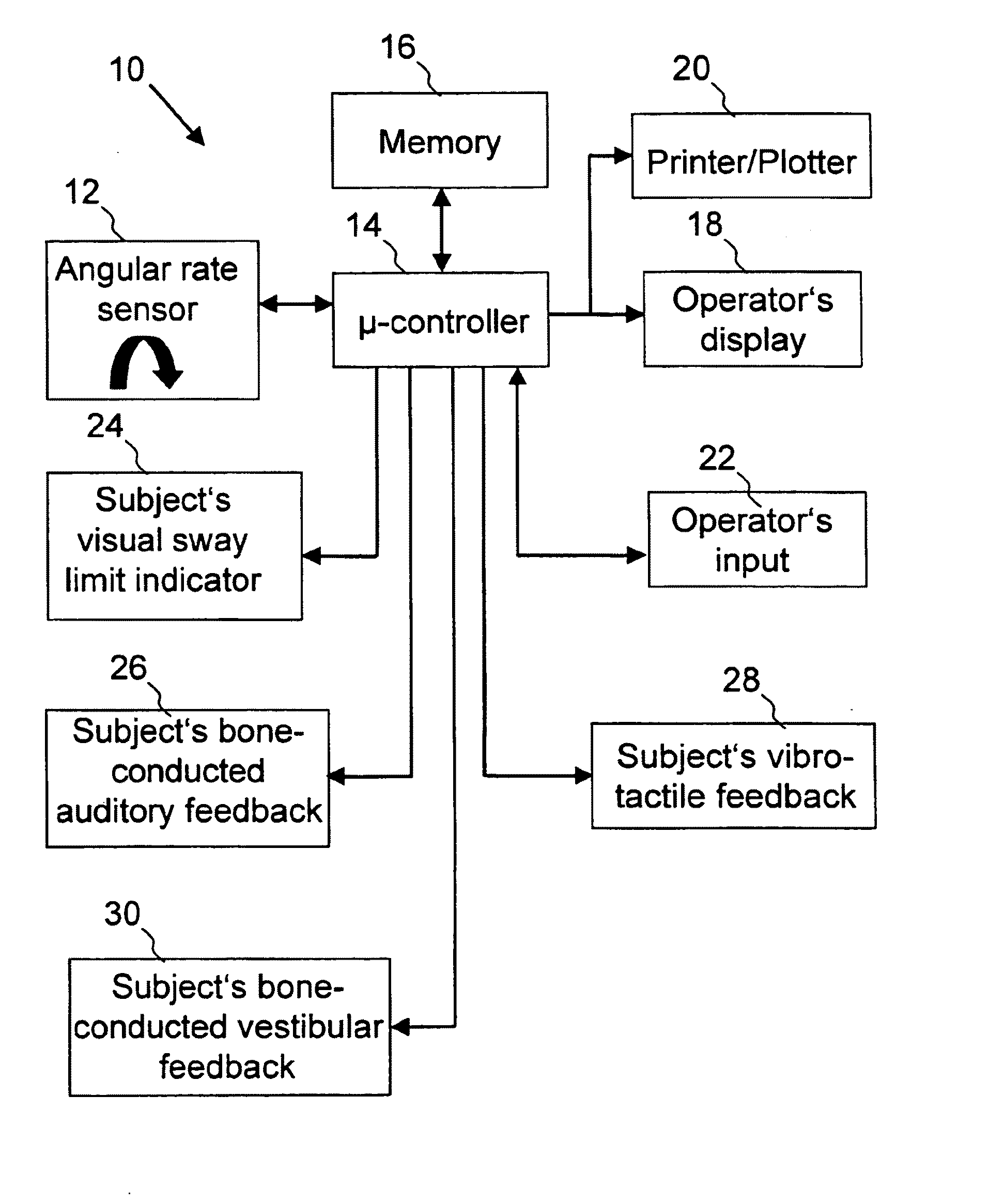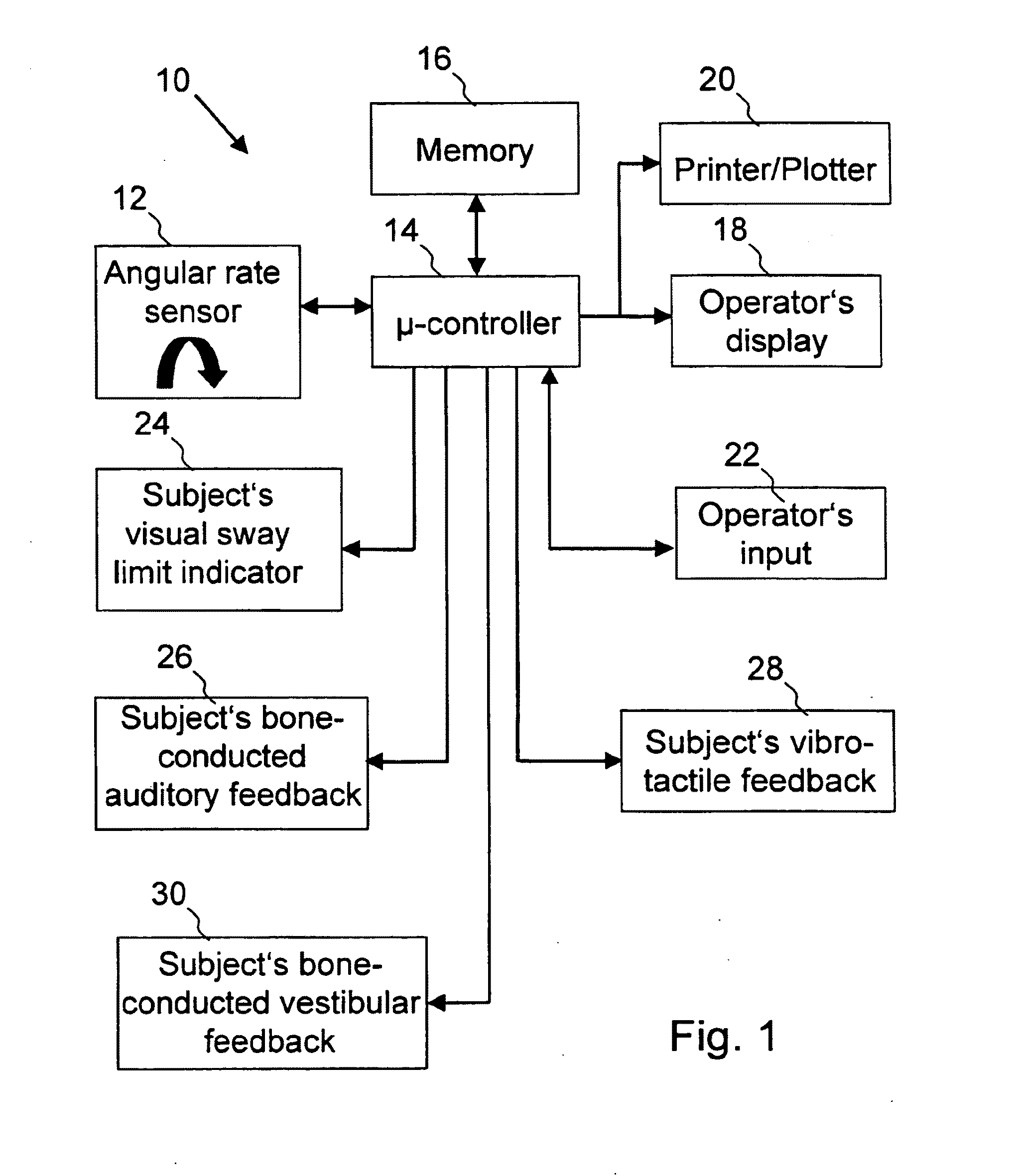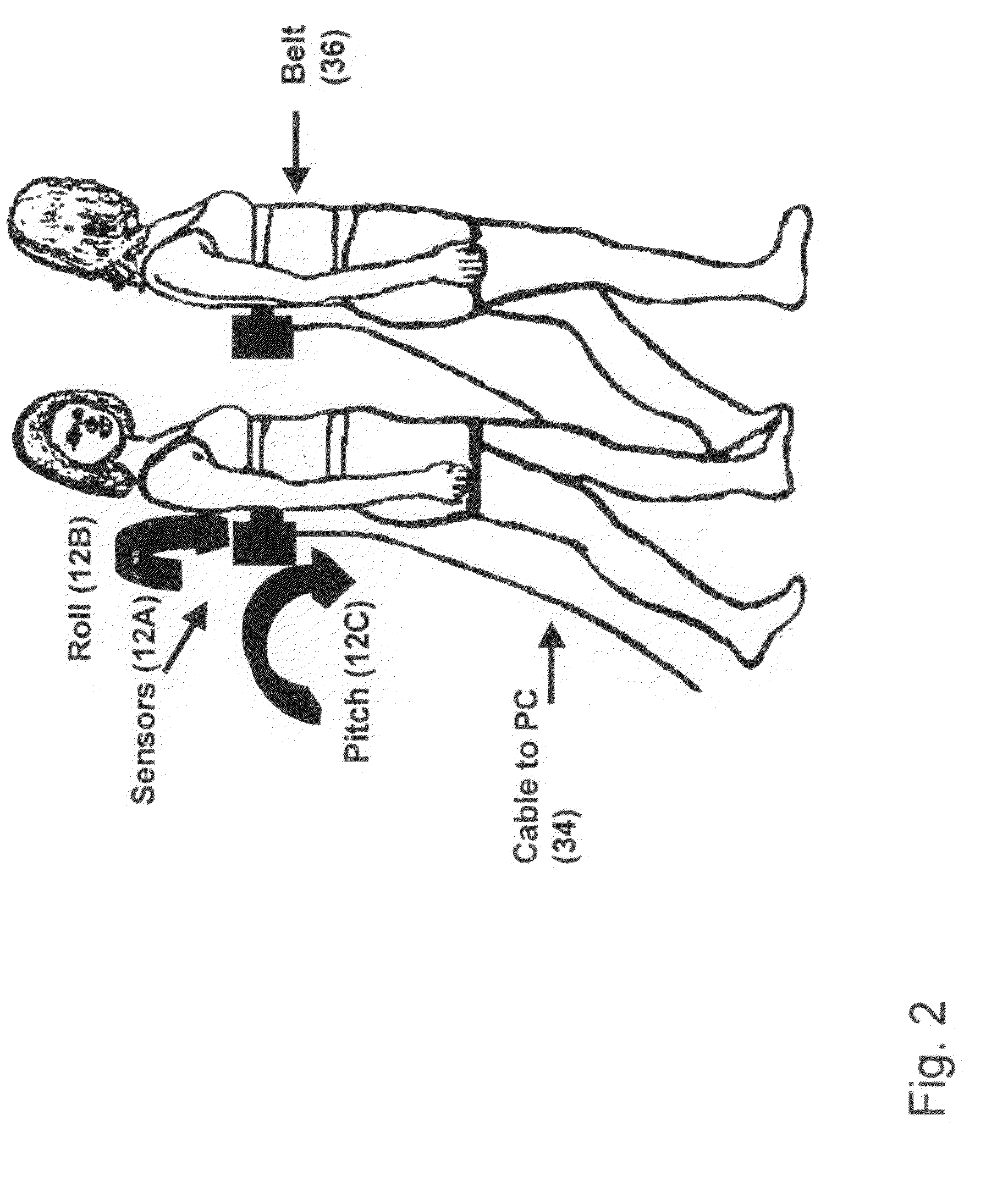[0008]It is an object underlying the present invention to provide a system / apparatus and a method for providing a body sway feedback to the body of a subject in a more reliable manner.
[0010]The present invention inter alia provides a system / apparatus and a method for providing a multi-
modal feedback information to a human subject of the subject's postural sway during standing or movement tasks. A method or device in accordance with the present invention may be used as a rehabilitory tool for subjects prone to abnormal falling or who wishes to improve their
movement control. The present invention may be used to provide prosthetic feedback to aid in the
rehabilitation of balance and
gait disorders without interfering with natural sensory signals. Because the prosthetic feedback is applied at the head in the form of a vibration it creates in the
skull bone-conducted auditory signals. Thus the interference with other, normally air-conducted, auditory signals is minimized. Furthermore the use of vibration at the
skull, above the level of the ears also excites vibro-tactile
skin receptors. The interference of such signals with
muscle proprioceptive signals when such a vibro-tactile
signal is applied near or on a
muscle will not occur. Finally the application of vibration at the head permits the excitation of vestibular receptors (vibro-vestibular) in the head using such signals.
[0014]For the
auditory feedback mode of the multi-
modal feedback, information on the amount of angular sway and / or
angular velocity of sway is presented to the subject aurally in the form of bone-conducted sounds transmitted via one or more vibrators which act as bone-conducting acoustic transducers. To be close to the
inner ear these are placed on the
skull over the left ear or over the right ear or over both ears. Three different audible centre frequencies, one for forward sway displacement, one for backward displacement and one each for left and right sway displacements are generally presented at each left and right transducer, respectively. The volume of these tones increases according to the feedback
gain as the subject sways in the
pitch and roll directions or combinations thereof. To make the tones for left and right displacement more noticeable the tone frequencies are shifted slightly in frequency every ca. 20 ms. The sway angle at which the tone is first heard, the depth of tone volume modulation with increasing sway angle, and the angle at which the tone volume increase is limited, as well as if feedback for sway in some directions is absent, are
auditory feedback parameters, which may be set by the operator to help improve the subject's control of body sway, and therefore improve the subject's balance control for one or more movement tasks.
[0015]Vibro-tactile feedback via
skin receptors can also be provided by the same or different vibrators mounted on a headband used to convey an acoustic signal to the ear. These vibro-tactile signals can be used to convey a sense of body sway. By placing several vibrators at different locations on the headband with spacing according to the sensitivity of the
skin of the head, that is, more vibrators at the back of the skull where tactile sensitivity of the skin is greater than at the front, and setting each vibrator on when angular sway of the body is in the direction of the vibrator, a sense of body sway in that direction may be perceived by the subject. The amplitude of the body sway may be conveyed by increasing the amplitude of the vibrators oscillations. As the vibrators will also set up a local bone-conducted oscillation of the skull, it follows from the aforementioned
auditory feedback mode of the present invention, that a bone-conducted auditory tone will also be perceived by the hearing sense of the ear when the vibro-tactile feedback is activated, and vice versa for the bone-conducted auditory feedback mode, depending on how far away from the bone next to the ears the vibro-
tactile transducer is placed. The threshold value, that is, the sway angle at which the vibro-tactile signal is first sensed either tactilely or auditory, the depth of vibro-tactile modulation with increasing sway, and the angle of sway in a direction of a particular vibrator that the modulation ceases to increase (or is limited), as well as if vibrators for a particular direction are active, are all vibro-tactile feedback parameters which may be adjusted by the operator to help improve the subject's control of body sway, and therefore improve the subject's balance control for one or more movement tasks.
[0016]Because it is well-known that vibration of the skull with a bone-conducting auditory transducer operating at a hearing level greater than 30 dB sensory level (where 0 dB represents the threshold of hearing for the subject), causes a sense of motion by activating vestibular receptors in the
inner ear, it follows that vibration of the head whether it causes an auditory and / or vibro-
tactile sensation will lead to excitation of vestibular receptors. Thus such excitation can also be used to convey a sense of body sway. The amplitude of such vibro-vestibular feedback may be conveyed by increasing the amplitude of the bone-conducting and vibro-tactile feedback once these have exceeded an auditory
sensation level of 30 dB sensory level. By recording potentials in
neck muscles in response to these stimuli it is possible to determine this threshold value individually and set this to a corresponding sway angle of the body. This sway angle at which the vibro-vestibular is first sensed, the depth of vibro-vestibular modulation with increasing sway, and the limit of sway when the vibro-vestibular modulation ceases to increase are all vibro-vestibular parameters which may be adjusted by the operator (albeit not independently of the acoustic and vibro-tactile parameters), to help improve the subject's control of body sway, and therefore improve the subject's balance control for one or more movement tasks.
[0017]A
visual feedback system according to this invention may augment the above mentioned
modes of feedback. For
visual feedback, a system of 4 light emitting diodes (LED) are incorporated into a peak of the head-band worn by the subject. Such a system of LEDs will be so mounted only to be in the
peripheral vision of the subject and not obstruct vision. The subject is thus able to see both the diodes and the world around him simultaneously. The
visual feedback diodes are each of a different color to indicate sway in the left, right, backwards and forwards directions. Each
diode flashes with an increasing frequency up to a frequency lower than the
flicker frequency (when independent flashes can no longer be distinguished) with increasing body sway. Normally the threshold when the diodes begin to flash is larger than the thresholds for other forms of feedback in order to act as a fall warning. The sway angle when the diodes are first illuminated, the
rate of increase in flash frequency with sway angle and the limit of sway when the flash frequency is held constant for further sway are all parameters which can be set and adjusted to help improve the subject's control of body sway, and therefore improve the subject's balance control for one or more movement tasks.
 Login to View More
Login to View More  Login to View More
Login to View More 


